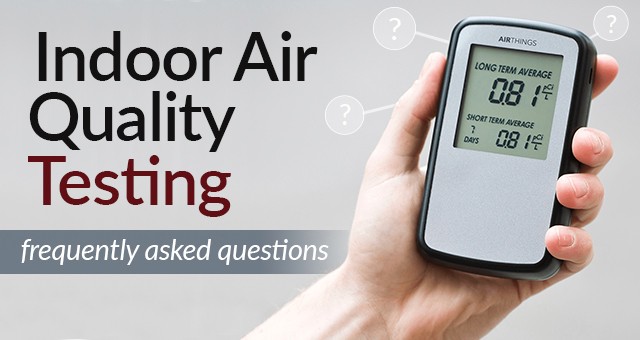SIGNS YOU SHOULD TEST YOUR AIR QUALITY
Indoor Air Quality Testing is a great way to make sure you’re not dealing with any problems, like mold, allergens, or radon.
If you have any health symptoms like chronic allergies and asthma, frequent headaches, bronchitis or colds that last an unusually long time, your body may be feeling the effects of pollutants in your home. And those airborne irritants could be anything from gas fumes to pet dander to mold that you can’t even see.
Sometimes the contaminants are more extreme, such as hazardous chemicals and asbestos. If you notice severe symptoms such as dizziness, nausea, rash, fever, chills, fatigue, vomiting or shortness of breath, you definitely need to have your air quality tested.

Why You Need Indoor Air Quality Testing
Improved Health Effects
Symptoms of poor air quality include nasal irritation, scratchy throat, headaches, nausea, and fatigue. The effects can mimic those of allergies, colds, and viruses. People with asthma may see worsened symptoms. If the effects occur in one place or area, and go away when you leave, the origin of your symptoms may be an indoor air source.
Over time, some indoor air pollutants increase the risk of respiratory disease, heart problems, and cancer. You can therefore improve your short- and long-term health by having your indoor air tested and taking measures to correct any problems.
Boost Your Comfort
The effects of poor indoor air quality vary from person to person. The symptoms alone can be downright uncomfortable. Nobody wants to have nose, eye, or throat irritation, but improving air quality can provide relief. Even a dull headache may be a symptom of something dangerous, such as carbon monoxide exposure. It’s therefore important to take note of your symptoms and have indoor air quality checked to be on the safe side.
Indoor humidity should be between 30% and 50%. Higher levels can make it feel warm and sticky and increase the risk of mold.
Increased Efficiency and Lower Electric Bills
Air quality issues often result from poor ventilation, which can cause your heating and cooling system to work harder. This increases the strain on the system, so it uses more energy, increasing your utility bill. Allowing air in from outside helps reduce concentrations of indoor pollutants. However, increased airflow from outdoors on a hot or cold day forces your HVAC system to compensate, so it’s important to carefully control ventilation in a building.
Improved Employee Performance
When workers are more comfortable, productivity tends to increase. Reducing the incidences of illness and poor air quality symptoms can equally lower absence rates and improve performance. By complying with the latest building standards and using surveys to determine employee comfort levels related to temperature, humidity, and other factors, you can narrow down the pollutants to test for.
Reduced Pet and House Odors
Smoke, combustion products, rodent droppings, mold, and other indoor pollutants can give off unpleasant smells. Oftentimes the problem is hidden deep inside your AC ducts. Foul odors can make people in your home or office miserable. Plus, they can indicate more serious problems that can put their health and safety at risk. A cleaner smell is also more inviting to guests, employees, clients, and visitors.


